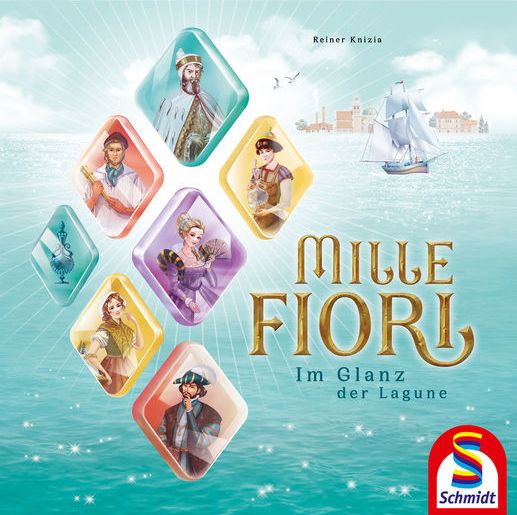Mille Fiori (English Edition)
Couldn't load pickup availability
Delivery and Shipping
Delivery and Shipping
For more details, please refer to our Shipping and Order Information.
Description
Description
| Designer |
Reiner Knizia |
| Publisher | Schmidt Spiele |
| Players | 2-4 |
| Playing Time | 60-90 mins |
| Suggested Age | 10 and up |
| Expansion | Mille Fiori: The Masterpieces |
In Mille Fiori, you take the role of glass manufacturers and traders who want to profit as much as they can from their role in the production of glass art.
The game board features different aspects of the glass production cycle: workshops where the glass is created, houses where it's installed, people who support your work, trade shops where it's sold, and the harbor where ships bring glass to faraway locations. You want to be present in all of these areas, preferably at just the right time to maximize your earnings. The game board features 110 spaces, with one card in the deck for each of those spaces.
At the start of a round, each player receives a hand of five cards; additionally, place as many cards as the number of players face up next to the game board. Each player chooses a card from hand, then passes the remaining cards to the next player, then each player plays their card in turn, beginning with the round's start player and typically placing a diamond-shaped token of your color in the location depicted on that card:
In the workshops, you score 1 point for each of your tokens in a connected group with the newly placed token, doubling that score if you played on a pigment field.
In the line of houses, you score the listed number of points, and if your token is preceded in the line by one or more tokens of your color, you score those previously played tokens again.
In the people pyramids, you score 1, 3 or 6 points based on the height of your token, but you can place at higher levels only if the lower spaces are filled. Double your points if the card symbol matches the space your filled. Supporting tokens score again as higher tokens are placed.
In the trade shops, four types of goods are present, and when you place a token, each token on that goods type scores for its owner points equal to the number of goods of that type now covered.
In the harbor, you move your ship equal to the number on the played card, scoring points based on the space where you land, then place a token in one of the five rows. When that row is filled with three ships, each token in that row scores for its owner 1/3/6/10 points depending on the number of trade goods in that row.
Alternatively, you can play a card for ship movement points and not place a token on the game board.
Each player plays four cards in a round (or only three cards in a two-player game), then places the remaining card(s) in hand beside the game board, then the start player marker rotates and you begin a new round.
For each of the five areas, you can meet a certain condition that allows you to play a bonus card from those on the side of the game board, e.g., in the workshops when you place the third card that surrounds a bonus card symbol and in the trade shops when you score a goods type that gives someone else more points than you. When you play a bonus card, you might trigger another bonus card...and then another!
Additionally, you have five opportunities to score 20/15/10/5 bonus points, e.g., in houses when you have placed tokens on houses of four different values and in the people pyramids when you have placed tokens on all three types in a pyramid. You can score each such bonus only once, and you score the highest available bonus at the time you achieve it.
When you can't deal a hand of five cards to each player or when someone has placed their final token, the game ends, then players add their bonus points to their current score to see who wins.


